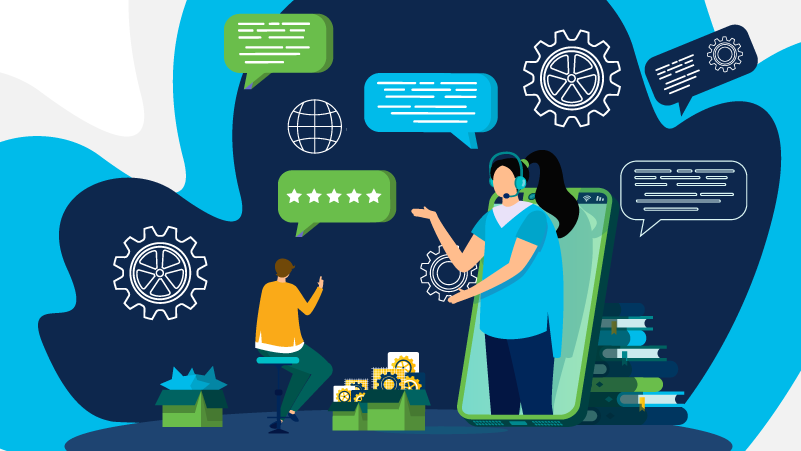“Your call is important to us.”
You’ve heard these words 87 times and are beginning to wonder if the disembodied voice on the other end of the line genuinely means it, complete with an endless musical jingle that drives you mad. And when you finally do connect with an actual human, the information you shared with a bot 45 minutes earlier isn’t transferred. In the end, you've lost valuable time and the problem still isn’t solved.
Suffice to say, most contact center experiences are not even close to satisfactory, even though these interactions are one of the best ways to build brand loyalty. But what if AI, voice recognition, and other innovative technologies combined to make these interactions fast, effective, and easy — for customers and agents?
In a Q&A interview, Giorgio Mihaila, Cisco's VP and GM of Webex Collaboration & Customer Experience solutions, shares how Cisco is helping businesses of any size exceed their customer expectations with interactions that are something to remember — for all the right reasons.
Q. Everyone has had a bad contact center experience. What makes it so frustrating for so many?
A. When you call into a business to get help, you want to get it fast. But too often, that is not what happens. Typically, the whole experience is super painful, starting with simply finding out how to contact the business. Is it a phone number, email address, or chat?
Then, you wait on hold for hours to talk to someone. And when somebody finally picks up, you go through the same authentication process all over again. It's time that you're never going to get back. A few years ago, a study said Americans waste 43 days of their life listening to music on hold, waiting to speak to someone. In many cases, businesses have no idea the pain their customers feel because they are presuming the absence of negative feedback is a sign of satisfaction.
In fact, 80 percent of companies believe they provide a fantastic experience, with only 8 percent of their customers sharing the same sentiment. Customers want their issues solved quickly, and many will research online through knowledge databases and look for self-service before calling. So, this massive disconnect exists between businesses that think they are providing customers with fantastic service but with poor access to information. This results in broken words and missed opportunities to build lifetime experiences.
Q. Can a good experience cement brand loyalty and customer loyalty?
A. Absolutely, if you think about your own personal experiences, they likely tell a similar story. For example, 72 percent of customers share positive experiences with six or more people; on the other hand, an unhappy one shares their experience with 15 or more. So, companies no longer have a choice; they must have services in place that exceed their customers’ expectations and build brand loyalty or risk loss of business.
Think about some of your favorite customer experiences from brands like Tesla, T-Mobile, American Express, or GoDaddy and why they've earned your loyalty for life. They start by building their products and services by making them easy to use and anticipating any customers' issues and addressing those in the product.
Then, when customers need to connect, companies that provide exceptional customer experiences start by providing digital-first communications options, followed by surfacing rich database knowledge articles — but with human agents on standby in case customers have more complex inquiries that need to be handled by a live agent. Finally, those companies have systems in place to derive relationships between operational, transactional, and experience drivers, like listening posts for sentiment and feedback, that go a long way towards identifying and course-correcting challenges before they impact your customer experience and brand loyalty.
Q. Companies like T-Mobile have set a high bar for customer service. How can others keep up?
A. Whether you are an un-carrier mobile provider like T-Mobile or a local business, you have to be ready to provide experiences that exceed customer expectations. So, what do free pizza, Netflix, or one hour of free Wi-Fi have to do with cell phone service?
Again, building brand loyalty and exceeding customer expectations has never been easier. Businesses of any size can create the same type of experiences for their customers. And with the advancements of cloud, AI, and machine learning, these types of experiences can be enabled at warp speed by anyone. Now, even a small business can provide customers with experiences like T-Mobile's at a low cost and without hiring 30 developers or ten administrators.
Having a digital-first strategy is crucial to any business that wants to exceed customer experiences, and we couldn't have made it any easier for our customers. For example, our customers using Webex Contact Center have powerful digital-first capabilities that deliver personalized, context-aware communications to customers across any channel, that can be managed and optimized with a few simple clicks in our low-code visual workflow builder. The best part is that we made these services available to any Cisco contact center customer, regardless of whether they currently have cloud or on-premises technology and provide it at no additional charge for businesses that purchased premium agent licensing.
While we make it simple for anyone to implement a digital-first strategy, businesses should also start identifying customer challenges and work on improving them. I recently went to an Amazon Go store, where I picked up a sandwich and sparkling water then walked out without the need to scan items or speak to a cashier. And I received confirmation of the transaction with a discount for my next visit via text. Improving these types of challenges with easy-to-use digital-first services will enable any business to compete with the biggest brands and, more importantly, exceed their customers' expectations.
Q. What innovations and new technology is Cisco employing to create a great customer experience?
A. I had teased some of the significant innovations we’re bringing to our customers earlier, but more come to mind. I’m most excited about the ones that have just become available that integrate features from imimobile products into our customer experience stack.
First, while the intuitive drag-and-drop workflow builder canvas enables both business and technical users to customize communication sequences, the real power of this new functionality comes from the ability to take events from any business system, and proactively provide customers with relevant, timely information tailored to their needs, using the specific communications channel they prefer most.
This visual workflow builder uses imimobile’s market-leading communications platform as a service (CPaaS) technology. And it’s foundational to creating differentiating customer experience functionality with low-code options that any business can use. Open APIs allow even more extensive customization capabilities.
A second exciting capability we’re integrating from imimobile is access to their vast library of digital communications channels, along with integrations to popular CRM systems like Salesforce, Zendesk, and more. This allows businesses to react to data from these systems to inform inbound engagements or trigger proactive outbound customer contact relevant to their real-time needs.
Finally, today over 60 percent of customers prefer self-service chatbots or an online knowledge base to contacting a human agent, but those resources need to be tailored to meet their needs; otherwise, their next go-to is a phone call. In fact, Gartner estimates that by 2030 a billion service tickets will be automatically created by bots. This makes it even more critical that businesses continue to invest in technology to ensure that customers can answer their questions using a wide range of self-service options.
To handle this demand, we’re enabling advanced self-service chatbot features from our recent IMImobile integration for both our cloud and on-premises contact center customers. Businesses get access to a bot builder that helps customers with their most frequent questions 24/7, with scalable usage-based pricing per bot interaction to match business needs.
Q. What makes Webex different than other providers in the market?
A. You know, one of the things I love in my new adventure here is that Webex by Cisco has been expanding the number of people in a business that can help customers for years by providing collaboration technology that integrates contact center and collaboration functionality.
But the reality is that Webex is so much more than just a contact center or a collaboration solution. That's just table stakes, and everyone should be offering these types of integrated solutions. So, one of the new services the Webex team has been relentlessly working on, and which is currently in preview, is related to learning in real-time the customer’s journey for any interaction. Touchpoints along that journey could be anything from browsing a page tracked via digital beacon, adding an item to a cart, talking to an agent, or even just capturing that a customer paused for a few moments to look at a display while at a physical store.
Imagine a customer walking into their favorite home improvement retailer, and if they happen to be pacing the same plumbing aisle for more than a few minutes, you could queue a concierge representative to help! Think how powerful these capabilities become when you use the entire Cisco networking and Webex collaboration products and services. Businesses can then use this information to personalize, optimize revenue, empathize, and as a blueprint to make improvements.
Q. And how would you describe a connected customer experience through Webex Contact Center?
A. Customer experience is so much more than just a contact center. Through its entire stack of products and services, Webex by Cisco enables businesses to orchestrate in-the-moment help for customers.
A connected experience through Webex starts with giving customers a voice in their interaction with your business using the journey technology I described earlier. It can then provide a blueprint for a digital-first strategy and improve existing deployments.
Using Cisco's Webex Contact Center capabilities, businesses can instantly connect with customers using Facebook Messenger, SMS, or chat and provide answers to the most common questions using an AI/ML-powered chatbot. If a customer needs to speak to an agent, we can pass all digital channel interactions and surface the next best actions using our contact center AI (CCAI) technology.
For example, suppose the subject matter expert that can help isn't part of the contact center. In that case, an agent can use the Webex App to bring anyone in the enterprise to help, using a direct path for calling and meetings functionality with presence awareness, all from the same central agent desktop they use today.
More importantly, these interactions are all integrated and tracked within a customer relationship management system, so businesses can now use events and triggers in these databases to proactively contact customers using the channel of their choice.
Tight integration with our rich community of partners simplifies identifying extraordinary agents and pairing them with agents that could learn from them.
So, a connected experience starts and finishes with a simple goal of exceeding customer expectations, while enabling businesses to adjust every touchpoint along their journey to ensure it is a delightful experience.
Q. This must make life a whole lot easier for the agents as well.
A. This is a great point; with so much focus on the customer, rightfully so, we can't forget the most valuable asset to any business: its people!
Even though it may not always seem like it, contact center agents want to help, and the customer experience is important to them. But, unfortunately, many of them are faced with slow processes due to outdated technology. And they contend with too many steps and the challenge of repetitive, cumbersome tasks to close out tickets, preventing them from engaging with more customers.
Businesses using our contact center AI technology see their agents become super agents by using services like real-time transcripts, live agent assistance, and intelligent self-service to improve their average call handling time, with a faster wrap-up and a dramatic improvement to first-call resolution. Because these services work automatically and, in the background, we can make agents into super agents by moving the functions out of the way and focusing on helping customers. In fact, customers that have implemented our contact center AI services report a reduction in agent churn and improved productivity due to minimizing repetitive cumbersome tasks with a focus on quality time spent on complex inquiries.
Q. What do you see for the future? How can we make the contact center experience even better?
A. I think technology will continue to integrate in a more meaningful way, where products and services are built from the ground up to anticipate your needs proactively. That will incorporate services like the Internet of Things where, for example, your refrigerator can signal that a filter needs replacement. Well, if you're like me, you don't even know where the filter is. But the manufacturer could automatically orchestrate a reach out and proactively source replacement filters, then schedule a video call with a representative to help you install it.
So, technology will enable businesses to be transparent or invisible but still be ready when you need that on-demand personal help by anticipating and proactively connecting with you. It will be like how driving my car sends a massive amount of data to Tesla. They use that data to proactively develop and anticipate things that I may need in the future, with proactive software updates while I sleep. Then, in the morning, I get a quick view of the improvements, complete with a little something extra to exceed my expectations, like one of my favorite streaming providers added to their operating system in the last update.
Customer experience will become part of the foundational development of any successful product that can proactively take signals for on-demand improvements redefining the voice of the customer. Customers will decide if they even need to interact with a contact center and if they do, it will likely be dramatically different than today.
Getting in-the-moment help will be table stakes for any business. Still, opportunities to make it memorable and exceed customer expectations will come from differentiating that experience by making it unforgettable. That could even include making the person helping you through your problem sounding or looking like your favorite celebrity! It's humbling to think about all the possibilities available for all businesses to exceed customer experiences, and what they will create using the Cisco products, services, and network that power the internet. I can’t wait to see what kind of experiences our customers will build next.
###
Related content:
- The great hybrid experiment
- Cisco launches a new accelerator program, Webex Leap
- All eyes on the contact centre: how banks can get customer experiences right with IT visibility



